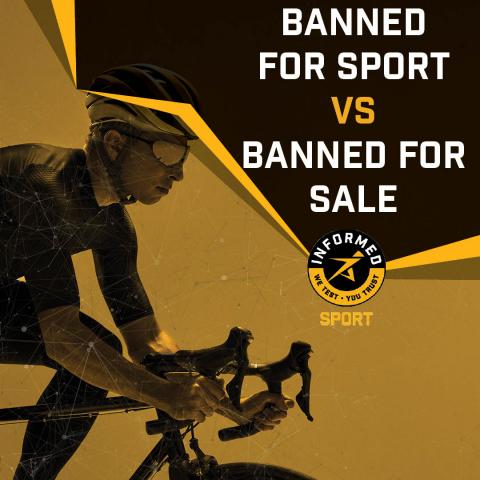INFORMED SPORT NEWS

Banned for Sport VS Banned for Sale
We regularly see news stories of athletes testing positive for a substance banned in sports. Many athletes who have a positive doping violation have cited that because a supplement was sold in a reputable store, they thought it was okay to use. It’s vital for athletes and drug tested personnel to remember that just because a substance is banned by sport does not mean it’s banned for sale. Even though many substances banned in sports are also illegal, there are many available by prescription or can be found as ingredients in sports and nutritional supplements and available for purchase at retail or online.
The following are examples of substances that are banned for sport, but used for medical purposes or commonly found as ingredients in sports and nutrition supplement products:
Anabolic Agents
One of the more commonly known classes of banned substances, anabolic agents are medically used to treat hormonal issues and diseases that cause loss of muscle[i]. One such compound that remains in the sporting news headlines is DHEA.
DHEA is found in supplements claiming to help with weight loss, depression, cervical cancer, sexual dysfunction and lupus[ii]. Despite the wide range of medical uses, DHEA is still banned for use in sports. Athletes and those who are drug tested should take even more precautions because of this. Should a supplement user use a supplement that is produced in the same facility as a DHEA supplement, there is a risk for cross-contamination.
A cyclist was banned from competition after inadvertently ingesting DHEA. The banned substance was found in a protein drink, even though it was not listed as an ingredient.
Peptide Hormones. Growth Factors, Related Substances, and Mimetics
Peptide hormones are prescribed to treat a variety of illnesses and diseases. Synthetic peptides, such as Sermorelin and Ipamorelin, are marketed as assistants for anti-aging, muscle building, and fat loss[iii]. These attributes are why peptide hormones, growth factors, and other related substances are banned for use in sports.
Beta-2 Agonists
Beta-2 Agonists are a class of drugs used to treat asthmatic conditions and obstructive pulmonary disease. There are some inhaled beta-2 agonists, such as salbutamol and salmeterol, which are permitted up to certain dose limits. However, there are others that can still be found within sports supplement products, such as higenamine.
Higenamine is a chemical found in several plants such as aconite, Annona squamosa, Nandina domestica (sacred bamboo) and others[iv]. It was banned by the World Anti-Doping Agency (WADA) in 2016, however, higenamine is still readily available in many pre-workout and weight-loss products. The substance can be listed under a different name on product labels, including:
- norcoclaurine
- demethylcoclaurine
- Aconite
- Annona squamosal
- Nandina domestica
- Tinospora crispa[v]
A rugby player unknowingly ingested higenamine that was found in his pre-workout supplement. Remember, it is vital to read every ingredient on the product label. Furthermore, to have full confidence in a supplement, ensure it has been third-party tested.
Hormone and Metabolic Modulators
An example of widely used hormone and metabolic modulators are Selective Estrogen Receptor Modulators (SERMS). SERMS are used as a treatment for breast cancer, osteoporosis, and post-menopausal symptoms. There is also some benefits of SERMS being used to decrease the frequency of non-vertebral fractures in elderly population[vi].
The National Anti-Doping Agency in India issued a 2 year suspension to a weightlifter who tested positive for SERMS. Read the full story.
Diuretics and Masking Agents
All diuretics are considered to be masking agents by WADA and have been banned in sports since 1988. Diuretics are used to treat medical conditions such as heart failure, high blood pressure, kidney and liver problems, and glaucoma. Examples include:
- hydrochlorothiazide
- desmopressin
- probenecid
- amiloride
- metolazone[vii]
The number one overall pick in the 2018 NBA Draft was suspended for 25 games, resulting in a loss of $2 million, for testing positive for a diuretic.
Stimulants
Obviously, stimulants like cocaine are illegal both in sports and for sale. However, stimulants play an important role in treating a range of medical conditions. Prescription stimulants are used for ADHD and narcolepsy.
Methylhexaneamine is a stimulant that can be easily found in supplements used for weight loss, bodybuilding, and improving performance. Beware of what is on the ingredients list located on the product label. Many times, Methylhexaneamine is listed as rose geranium, geranium oil, or geranium stems[viii]. It may even be used in a brand’s proprietary blend which means it won’t be clearly listed on the label.
A ruby player ingested a supplement containing methylhexaneamine. Even after doing his own research, the product was found to contain the banned substance. Prior to taking any supplements, consult a dietitian and ensure it has been third-party tested.
Narcotics
Narcotics are pain relievers that should only be used under a healthcare provider’s recommendation and prescription. The following narcotics are listed as banned in the latest WADA Prohibited List: Buprenorphine; Dextromoramide; Diamorphine (heroin); Fentanyl and its derivatives; Hydromorphone; Methadone; Morphine; Nicomorphine; Oxycodone; Oxymorphone; Pentazocine; Pethidine.
Cannabinoids
According to WADA, all natural and synthetic cannabinoids are prohibited, with the exception of Cannabidiol. Cannabidiol is commonly used for epilepsy. Despite claims that it is an effective treatment for a wide range of other diseases and illnesses, there isn’t scientific evidence to prove that. CBD products could contain levels of other cannabinoids banned by WADA or even traces of THC[ix]. This could lead to a positive doping test.
Glucocorticoids
Glucocorticoids are widely prescribed for inflammatory and autoimmune diseases including multiple sclerosis, rheumatoid arthritis, ulcerative colitis, psoriasis and eczema[x] According to WADA, “All glucocorticoids are prohibited when administered by oral, intravenous, intramuscular or rectal routes.”
Read how a cricketer was suspended due to inadvertently ingesting a glucocorticoid that is prohibited in competition.
The Importance of Using Tested Supplements
As an athlete or drug tested person, it is your responsibility to know the ingredients in the supplements you’re taking. Although a substance is prohibited in sports, it can still be widely available for medical purposes. There are many sports and dietary supplements sold that contain some form of a banned substance. Even if a substance is not included on the ingredient list, the supplement could have been contaminated during the manufacturing process, supply chain, or by way of raw material which could lead to inadvertent doping. The aforementioned articles are just a few examples of how prevalent inadvertent doping is.
Ensure your supplements are safer for use by only using supplements tested and certified by a third-party testing and supplement certification programme, like Informed Sport. Informed Sport is the only global banned substance testing programme that tests every single batch prior to it being released to market. Certified supplement products are tested for over 250 banned substances. While no analysis will encompass all the analytes listed in the WADA Prohibited List, we are constantly developing new technologies and using our relationships with international anti-doping organisations and partnerships within the sporting industry in order to provide appropriate coverage for new and emerging threats.
Want to learn more about the importance of banned substance testing? Download our Comprehensive Supplement Safety Guide!
Informed Sport. Why Risk It?
[i] National Institute on Drug Abuse. (n.d.). Anabolic Steroids. Retrieved from https://www.drugabuse.gov/publications/drugfacts/anabolic-steroids
[ii] Newman, T. (2018, June 14). Dehydroepiandrosterone (DHEA): Uses, side effects, and interactions. Retrieved from https://www.medicalnewstoday.com/articles/308684#risks
[iii] Peptide hormones as ingredients in supplements. (n.d.). Retrieved from https://www.opss.org/article/peptide-hormones-ingredients-supplements
[iv] Higenamine: Health Benefits, Uses, Side Effects, Dosage & Interactions. (2019, September 17). Retrieved from https://www.rxlist.com/higenamine/supplements.htm
[v] Higenamine: What Athletes Need to Know to Compete Clean: USADA. (2020, January 3). Retrieved from https://www.usada.org/spirit-of-sport/education/higenamine-what-athletes...
[vi] An, K.-C. (2016, August). Selective Estrogen Receptor Modulators. Retrieved from https://www.ncbi.nlm.nih.gov/pmc/articles/PMC4995266/
[vii] Mischa. (2017, November 7). Drugs in sport. Retrieved from https://www.science.org.au/curious/people-medicine/drugs-sport
[viii] Dimethylamylamine: Health Benefits, Uses, Side Effects, Dosage & Interactions. (2019, September 17). Retrieved from https://www.rxlist.com/dimethylamylamine/supplements.htm
[ix] Lachenmeier, D. W., & Diel, P. (2019, December 14). A Warning against the Negligent Use of Cannabidiol in Professional and Amateur Athletes. Retrieved from https://www.ncbi.nlm.nih.gov/pmc/articles/PMC6956040/
[x] Case-Lo, C. (2018, September 29). Glucocorticoids: List, Uses, Side Effects, and More. Retrieved from https://www.healthline.com/health/glucocorticoids#uses







